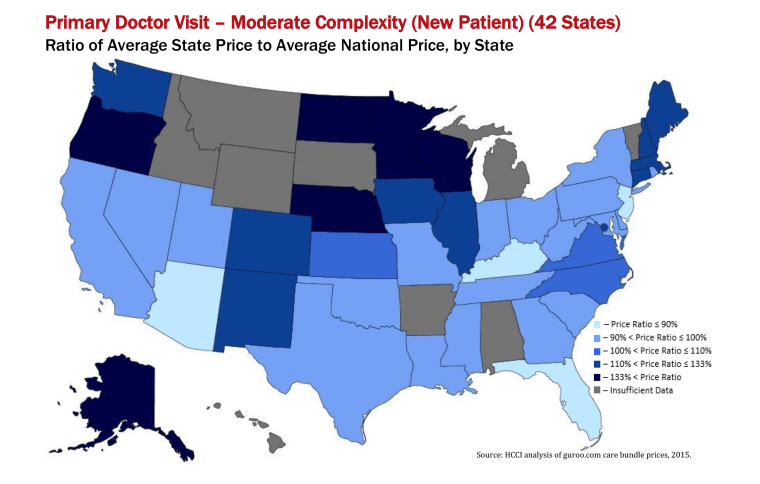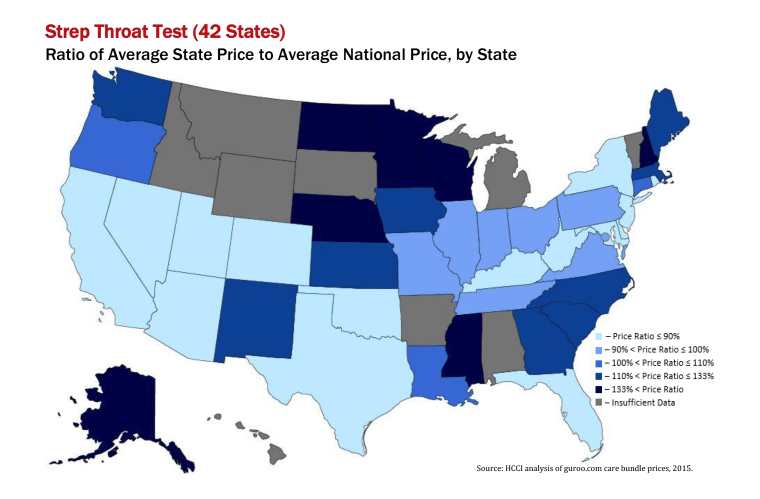Why does a knee replacement cost $29,000 in Kansas but $40,000 in next-door Colorado?
Health care prices are all over the map in the U.S., a new study finds. It digs deeply into the crazy pattern of health costs across the U.S. and shows there is very little consistency.

The report from the Health Care Cost Institute (HCCI) finds prices for the same procedures vary by sometimes huge amounts — even within the same state.
Unlike other reports, this one looks at prices paid by people with private health insurance.
“Prices for medical services varied more than threefold in certain instances,” the team wrote in the report, which was published in the journal Health Affairs.
Related: Drug Companies Boost Prices
Some of the differences make some sense. Prices overall in Alaska are high, and medical costs there are 2.6 times the national average. Medical costs in Florida are just 79 percent of the average.
“There is a big shortage of child psychologists in this country. If you are a single child psychologist somewhere in rural Pennsylvania, you are able to charge a high price because there are children lined up down the hallway," HCCI executive director David Newman told NBC News. In that case, high prices are a symptom of a shortage.
“Where a hospital has a monopoly, then prices tend to be much higher than those areas where there are multiple hospitals."
“In some towns, the hospitals have consolidated. In some towns the imaging has consolidated. In some towns there is an ambulatory imaging center; in other towns there is not,” Newman added.
Consolidation means the hospitals have more clout in setting prices, said Cynthia Cox of the Kaiser Family Foundation, which studies healthcare.
“Where a hospital has a monopoly, then prices tend to be much higher than those areas where there are multiple hospitals,” said Cox, who was not involved in the study.
Related: Mammogram Costs Vary by $1,000
But other differences are harder to explain.
The national average for a knee replacement is $33,098, the organization found. But this operation costs nearly $39,000 in Indiana and Minnesota, $40,000 in New Hampshire and Wisconsin and $43,000 in Oregon, while you can get one for just $24,000 in New Jersey. In Sacramento, California, a knee replacement costs $57,000, while the California average is just under $40,000.
An ultrasound for a pregnant woman costs an average of $268. But Alaskans pay $895 for the scans and they cost $201 in Arizona. Got cataracts? It’ll cost you $8,000 to get one removed in Alaska, compared to $2,300 in Florida. The national average? $3,300.
“The average price in Cleveland ($522) was almost three times that in Canton ($183), even though these two Ohio (cities) are only 60 miles apart,” the HCCI team wrote.
“Some of the variation in imaging prices is eight-fold around the Philadelphia area,” Newman added.
The team used the organization’s health cost website Guroo to research the report. “Aetna, Humana and United give us all of their paid claims data. It amounts to data on about 50 million Americans from 2007 forward,” Newman said.

Other studies have also shown prices varying wildly across the country. One of the best-known databases is the Dartmouth Atlas, which uses Medicare data.
Even in that single-payer system, the government pays twice as much for treating a patient in Miami as in San Francisco. People in the more expensive areas don't get better care.
“It’s not necessarily the case where if you pay more you get more,” Cox said.
Most Americans – more than 60 percent or 190 million people -- are covered by private health insurance, usually through an employer. About 32 percent have government health insurance of some kind, such as Medicare or Medicaid.
Related: Workers Shoulder More Health Costs
Medical costs can be paid by private insurance companies, directly by employers, by government-funded systems such as Medicare or Medicaid, and directly by patients. Hospitals negotiate different rates with different payers. Doctors and clinics sometimes do, too.
One study found that some hospitals mark up charges by as much as 1,000 percent.
“Prices for medical services varied more than threefold in certain instances."
“The concern is these higher prices get passed on to the consumer in the form of high co-pays and premiums,” said Cox. Her organization found that the average deductible for people with employer-provided health coverage increased from $303 in 2006 to $1,077 in 2015.
And this price variation helps explain why U.S. has higher healthcare costs than other countries, Cox added.
Americans now spend $9,523 per person a year on medical expenses — by far the most among developed countries.
The report leaves out nine states. There wasn’t enough data for eight of them, and Arkansas has a law forbidding its data from being incorporated into a national database.

